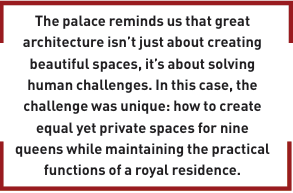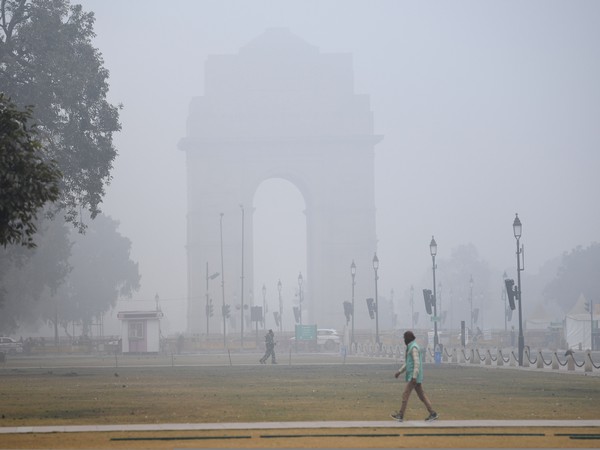
Perched like an eagle’s nest 700 feet above Jaipur, Madhvendra Palace defies the typical narrative of Rajasthan’s royal architecture. While most palaces sprawl outward, this unique residence soars upward, its nine apartments clustering around a central courtyard like petals of an elaborate flower. Built by Sawai Ram Singh for his nine queens, it stands as perhaps history’s most ambitious attempt to solve the challenge of keeping multiple royal consorts equally content.
A Palace in the Clouds
At first glance, Madhvendra Palace appears to float above the Pink City. The 15-kilometer journey from Jaipur’s bustling streets to this ethereal sanctuary involves a steady climb that seems to leave the modern world behind with each turning. As the elevation increases, the air grows noticeably cooler, and the city’s clamor fades to a distant hum.

Architecture of Equality
The palace’s most remarkable feature isn’t its height or its views, but rather its unprecedented architectural democracy. In an era when royal favorites often received grander accommodations, Sawai Ram Singh commissioned a structure where each queen’s apartment was identical in size and splendor. This architectural equality speaks volumes about the maharaja’s diplomatic skills in managing domestic harmony.
The Mathematics of Love
The palace’s layout follows a precise geometric pattern. Nine apartments, each a perfect mirror of the others, span three sides of a central courtyard. These residential wings rise two stories, creating intimate spaces that somehow manage to feel both private and connected to the larger complex. The fourth side, housing the maharaja’s quarters, completes this architectural symphony of space and symmetry.

Gardens in the Sky
Perhaps the palace’s most surprising feature is its elevated gardens. Despite the challenging altitude and arid climate, the complex includes carefully planned green spaces. These gardens served both aesthetic and practical purposes, providing private outdoor areas for the queens while helping to moderate the desert temperature through the strategic placement of vegetation and water features.
A Canvas of Stories
The palace walls tell tales in color and form. Each apartment showcases distinctive floral motifs and murals, their designs reflecting both Rajput artistic traditions and the individual tastes of their occupants. The paintings range from delicate botanical studies to elaborate scenes from mythology, creating a visual encyclopedia of 19th-century Rajasthani artistic styles.
The Science of Comfort
Medieval comfort might seem like an oxymoron, but Madhvendra Palace incorporated sophisticated environmental engineering. The thickness of its walls, the placement of windows, and the arrangement of courtyards created natural ventilation systems that kept interiors cool during scorching summers and warm during chilly desert nights.

A Room with Nine Views
While each apartment offered its queen privacy, all shared one spectacular amenity: unparalleled views of Jaipur. From this elevation, residents could watch the Pink City transform through the day’s changing light, from dawn’s first blush to the golden glow of sunset. These vistas weren’t just scenic, they provided strategic oversight of the kingdom below.
The Fourth Wall
The maharaja’s wing, occupying the fourth side of the courtyard, presents an interesting architectural counterpoint. While equal in height to the queens’ apartments, its interior layout differs significantly. Here, spaces were designed for both private residence and public duties, with rooms that could transform from intimate family gatherings to formal state meetings.
Hidden Passages and Whispered Secrets
A network of corridors, staircases, and passageways connected the various apartments, allowing for both privacy and communication. These architectural features tell us much about life within the palace, how servants moved unseen, how messages were delivered, and how the complex domestic life of a royal household was carefully choreographed.

The Art of Detail
Close inspection reveals the extraordinary craftsmanship invested in every corner of the palace. From intricate latticework that filtered harsh sunlight to elaborately carved door frames that marked transitions between spaces, each element was executed with remarkable precision. The palace stands as a testament to the skills of 19th-century artisans who combined functionality with aesthetic excellence.
Preserving the Past
Today, conservation efforts focus on maintaining this architectural treasure while making it accessible to visitors. Careful restoration work has preserved original features while stabilizing structures against the effects of time and weather. Modern additions, where necessary, have been thoughtfully integrated to maintain the palace’s historical integrity.
Living Heritage
Unlike many historical monuments that feel frozen in time, Madhvendra Palace maintains a living connection to Jaipur’s cultural life. The space occasionally hosts cultural events, art exhibitions, and heritage workshops, allowing it to serve as both a historical monument and a contemporary cultural venue.
A Day in Royal Life
Visiting the palace today, one can piece together the daily rhythms of its original residents. Morning light would have filtered through eastern windows, while afternoons might have found queens retreating to shaded courtyards. Evenings would have seen life move to the western apartments, where residents could enjoy spectacular sunsets over their domain.
Beyond Architecture
The palace offers insights into more than just architectural history. Its very existence speaks to the complex social structures of royal Rajasthan, the role of women in court life, and the ways in which architecture could both reflect and influence human relationships.
Practical Information for Heritage Enthusiasts
For modern visitors, the palace offers multiple levels of engagement. A basic tour takes about two hours, but serious architecture and history enthusiasts might want to allocate a full day. Early morning visits offer the best light for photography and more comfortable temperatures for exploration. Guide services, available through the city’s tourism office, can provide deeper insights into the palace’s history and architecture.
A Legacy for the Future
As Jaipur continues its rapid modernization, Madhvendra Palace serves as a crucial link to the city’s past. Its preservation isn’t just about maintaining old buildings, it’s about understanding the sophisticated social, architectural, and artistic achievements of our ancestors.
The palace reminds us that great architecture isn’t just about creating beautiful spaces, it’s about solving human challenges. In this case, the challenge was unique: how to create equal yet private spaces for nine queens while maintaining the practical functions of a royal residence. The solution, executed with both elegance and precision, continues to inspire visitors and architects alike.
Standing in the central courtyard as evening approaches, watching shadows lengthen across walls that have witnessed countless royal dramas, one can’t help but feel connected to the human stories that unfolded here. Madhvendra Palace is more than just a tourist destination, it’s a masterpiece of architectural diplomacy, a testament to royal romance, and a reminder that the best architecture serves both practical needs and human aspirations.
For those willing to make the journey up to this eagles’ nest of history, Madhvendra Palace offers something increasingly rare in our modern world: a chance to step into a past where architecture wasn’t just about building walls and rooms but about creating spaces that could nurture both individual privacy and communal harmony.















